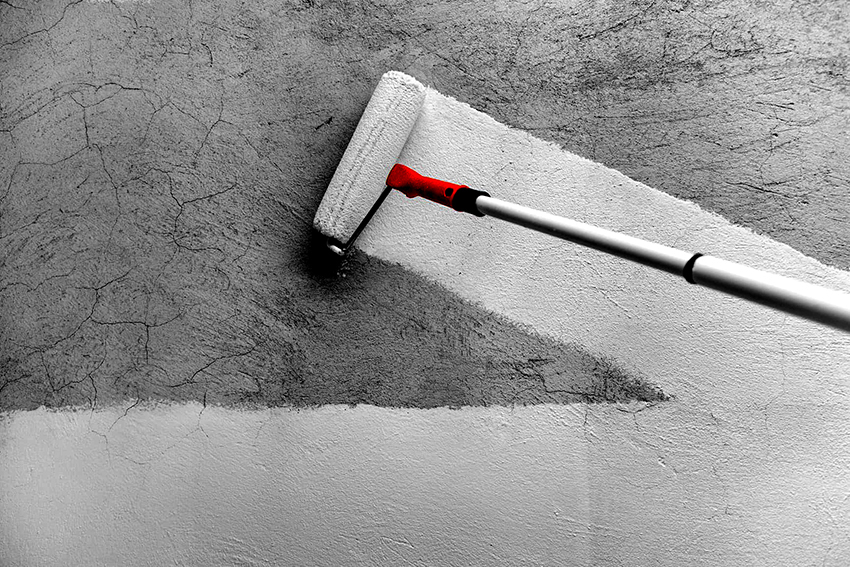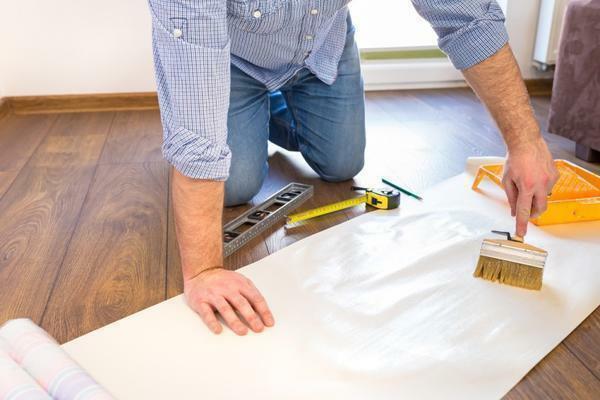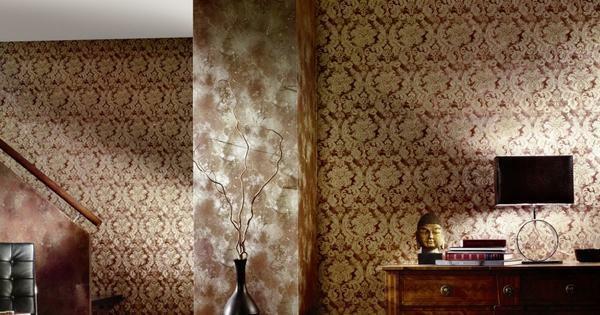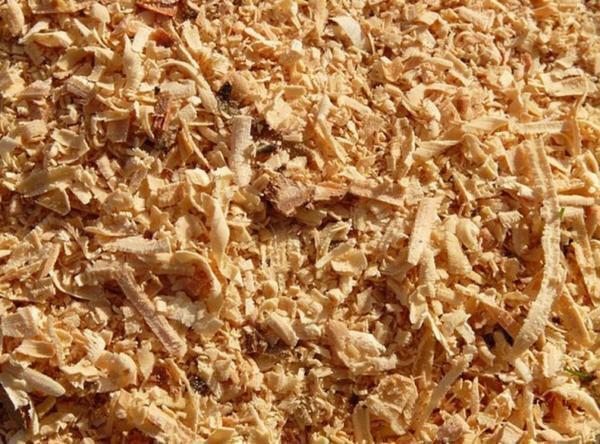SHARE
in social networks
Any repairs is not only time consuming but also costly exercise. So that the costs were justified, should pay special attention to quality materials. One of the innovative developments in the construction industry is fiberglass. This material is used as a basis for the finishing of the surface. This article provides information about what is a fiberglass for painting and how his mount technology.

Fiberglass for painting - an innovative material for reinforcement of walls and ceilings
Content
- 1 What is fiberglass paintable
- 2 Advantages and disadvantages of cobwebs under painting
- 3 Varieties of fiberglass ceiling and wall
- 4 Characteristics Stekloizol: rolled material on the basis of glass fiber
- 5 Well-known manufacturers of the paint glass fiber-webs
-
6 How to glue fiberglass: the algorithm of work
- 6.1 Fiberglass for painting: Lead mount technology
-
7 What glue fiberglass: the choice of the correct composition
- 7.1 What glue fiberglass: other variants of formulations
- 8 Characteristics of glue "Oscar" for glass fiber
- 9 Preparation for painting glass fiber: important recommendations
- 10 Staining of glass fiber on the ceilings and walls
What is fiberglass paintable
The first step is to understand what fiberglass. Material presented nonwoven web which is derived from the smallest of glass fibers by means of extrusion technology. Thanks to the external appearance of a semi-transparent thin products it is called masking cobweb. This can be seen in the photo of glass fiber for painting. The yarns are interconnected in a random manner by an adhesive composition based on organic resins. The main raw material for the material is quartz sand.

Fiberglass can also be used in a variety of construction and maintenance areas
Fiberglass is sold in rolls of a width of 1 m and a length of 50 m. The density of the material may vary within 25-50 g / m², which is selected depending on the application of the material plane. For vertical surfaces need to take a glass cloth of lower density, more dense material to be used for the walls.
The main purpose is to prepare the base material for finishing. Application of glass fiber makes it possible to avoid the formation of cracks on the surface. It allows you to align the base without the use of global and labor-intensive work, such as plaster ceiling and walls.
Its main function is the reinforcement surface. Prepared in this way the surface will retain its pristine attractive appearance for many years, eliminating the need for masking any cracks. The material is fixed by means of glue mixture, followed by staining or wallpaper pasting. Fiberglass may be used for various reason smokers any purpose.
The material is characterized by flexibility and a wide field of application in various fields of construction. It can be used in carrying out the drainage holes, for waterproofing company, manufacturing and wall panels floor lining, Food mastics when creating the roof and to increase the period of use of metal tubes.

Paint fiberglass - a non-woven fabric consisting of glass microfibers
Advantages and disadvantages of cobwebs under painting
Fiberglass under the wallpaper or paint characterized by high resistance to temperature changes. Preparation of the base may be performed at a temperature of from -40 to +60 ° C, without affecting the surface quality. The material has breathability and hygienic. Fiberglass does not attract and accumulate dust because of antistatic qualities. It precludes the possibility of condensate formation on the surface, which cause nucleation of mold and mildew.
Fiberglass spider characterized hypoallergenic, which is especially important for young children and people with allergies. They do not have any adverse effects on human health that is caused by their environmental friendliness.
One of the significant advantages of the material is its flammability. One can not but highlight the high wear-resistant quality, making for an extended period will retain its original appearance, which eliminates the need for frequent repairs. Such a surface can be painted several times. Fiberglass an affordable cost, with the result that the repair can be done efficiently and inexpensively.
Despite the large number of positive factors, fiberglass has a fairly serious drawbacks. With pictures need to work very carefully, since the stowage can sliver small fragments of glass. This could cause harm to health.

Pautinka paintable characterized hypoallergenic and resistant to temperature extremes
Getting on the skin, causing itching steklofragmenty. A more serious consequence of which will require a visit to a doctor is entering items in the respiratory system and vision. Therefore, it is necessary to work in a closed clothes, gloves, masks and goggles.
Varieties of fiberglass ceiling and wall
In construction there are three main types of glass fiber. The first embodiment, which is often called cobweb ceiling, has a density of 25 g / m². Weight 1 m² of the material is only '25 The use of glass fiber justified ceilings for painting, because fiberglass is lightweight, thanks to which it is convenient to glue.
The distinctive advantages of the material can also include a small flow of paint that will be needed to finish. However, low density glass fiber can be used for surfaces that do not have large cracks and unevenness.
Universal cobweb considered fiberglass density of 40 g / m², the strength of which is twice the previous embodiment, however, it has a lower cost than thicker counterparts. Such material is used for surfaces that are more vulnerable to mechanical stress, which is more typical for the walls. However, it can be glued on the ceiling, which is decorated with shabby stucco. Such a glass cloth is also acceptable for finishing wall and ceiling coverings smokers who perceive high vibrational load.
Fiberglass for painting differ different levels of density
One option is the most durable fiberglass density of 50 g / m². Material capable seal the large cracks. It can withstand high mechanical loads, so this cobweb should be used in finishing production facilities, workshops, garages, where there is a high probability of structural damage fencing. Installation costs of such material is much higher than the previous price gluing counterparts, due to the greater weight of products, and significant amounts of adhesive webs.
Important!High-strength glass fiber is not recommended for use in apartments and homes.
Characteristics Stekloizol: rolled material on the basis of glass fiber
Roofing well-proven fiberglass "Technonikol", which is applied to the surface vysokookislenny bituminous composition with mineral additives. As a protective coating may be used a resin film or sprinkling coarse fraction.
The material is characterized by biological stability, resistance to ultraviolet rays and temperature differences, environmental safety, high insulating qualities, zvukopogloschaemostyu, low thermal conductivity, strength, flexibility, elasticity, ease of installation and durability.

Stekloizol characterized by toughness and low thermal conductivity
Stekloizol comes in several varieties. HSP material is characterized by low tensile strength. On fiberglass is specialized film. Such backing layer provides a reliable base protection from moisture. The material can also be used as a waterproofing material for pipes and underground structures.
CCI rolled material has a high tensile strength and increased resistance to considerable mechanical loads. On both sides of the web are fusible resin film, which eliminates the sticking probability of the material during transport and during storage. This Stekloizol type is also used as a substrate under the roofing.
Fiberglass HSS has a protective coating in the form of crumbs krupnofraktsionnoy slate, on top of which is applied a protective polymer sheath. Such a material for the roof of the upper layer device.
Important! HSS fiberglass is applied to flat surfaces with a slight slope.

Stekloizol is an indispensable material for roofing
Most durable fiberglass cloth is TAP, which is based on the skeleton fiberglass coated top krupnofraktsionnym slate granulate and a protective plastic film. Such material is used for arranging roofs with a slope of 10 °.
Well-known manufacturers of the paint glass fiber-webs
To select the high quality material should pay attention to the fiberglass mat made by known manufacturers. Are proven companies Wellton, Spektrum, Oskar, Samtex. Depending on the density of the material price of glass fiber for painting will be 800-1500 rubles. per roll.
Swedish manufacturer Oskar offers high-quality products, which has good durability and affordable price. Tear or cut the cobweb can be extremely special, sharp object. For coloring of the glass fiber "Oscar" will need a minimum amount of ink, even when performing painting works without the use of fillers. Buy Oskar glass fiber can be 1200 rubles. per roll.
Demand Samtex reinforcing material for protection of surfaces from cracks. Pautinka is durable, hypoallergenic, abrasion resistance and good energy-saving properties. Buy a versatile material for the decoration of walls and ceilings can be from 800 rubles. per roll.

Fiberglass from Oskar company can be purchased from 1200 rubles. one roll
In carrying out painting and repair works is very popular fiberglass Finnish company Wellton. Spider has high fire safety, stability to moisture, high temperatures and corrosive environments, high density, hypoallergenic, and prolonged use. Material cost is 1000-1200 rubles. per roll.
It specializes in the production of high-quality fiberglass mat at an affordable cost Dutch company Spektrum. The material may be applied to any surface. The special place in the product range reserved thick fiberglass, which provide protection wall surface from cracking and other damage. Stekloholsta price starts from 600 rubles. per roll.
How to glue fiberglass: the algorithm of work
Before gluing fiberglass for painting, it is necessary to ensure optimum working conditions. It is necessary to examine the wall for the presence of visible defects such as cracks, potholes and other defects. They must be removed by means of plaster or filler mixture. Next the base is treated with special primer composition, which must have a good penetrating power. This mixture facilitates alignment of the surface structure, dust binding and filling microcracks.
Important! Stekloholsta glue on the wall or ceiling surface is performed at a temperature of 15-25 ° C, relative humidity not higher than 60%, excluding drafts and direct sunlight.

Before gluing glass fiber surface must be primed
After application of the primer is necessary to keep the time for it is fully dry. This is very important, since the formation of small crystal lattice, having a high adhesion. This film will be affected, if not wait for drying the base closure.
Before gluing fiberglass on the ceiling or wall, it is required to prepare a material. It is very inconvenient to work with long one-piece cloth. They are cut into convenient to work elements. Thus it is necessary to observe the presence allowances (1-2 cm) at the edges. Next is preparing the adhesive. It is applied to the backside of the fabric strip width and sides, spreading a thin layer - 1-1.5 mm.
Important! Consumption of 10 g per 1 m² webs.
Fiberglass for painting: Lead mount technology
When the work is important to consider how to glue the glass fiber. The process starts from the corner plane. It can be wall or ceiling. After gluing the first strip overlapping the second fixed member which is subsequently trimmed. Pile on the material has to look in one direction. Otherwise surface after dyeing is unaesthetic. Thus, the remaining parts are mounted finishing.

Before gluing cobweb need to wait for the complete drying of the surface
Price gluing glass fiber depends on the trim plane. The cost of the headlining will be slightly higher compared to the price pasting of walls.
Adhered to glass fiber gypsum board material should be placed so that its butt joints do not coincide with joints between plasterboard sheets. To eliminate this moment must first mark bottom.
Related article:
Mural on the wall: how to glue different types of products
Terms of bonding different kinds of fabrics. Preparing walls, materials, tools. Step by step photo and video instructions on wallpapering.
An important step is the careful docking adjacent bands. Joints should be further impregnated with glue and pressed well spatula. Finished trim must be completely dry, which will need 2 days. The material can be glued on their own or hire a specialist for finishing the surface with glass. Price per m2 starting from 150 rubles.
Useful advice!For more reliable fixing of glass fiber is recommended to additionally lubricate the top surface of the adhesive liquid consistency.

For ease of installation glass fiber cut into individual webs based allowance
What glue fiberglass: the choice of the correct composition
two options can be used for adhesive sticking to the glass fiber surface: dry powder and mixture was ready. It is important to choose the compositions intended for this particular material. Glue is not suitable for paper wallpaper. This is due to the fact that fiberglass is heavier than the paper, so conventional composition can not withstand such weight. Besides, glass fiber fabric structure is woven fibers that adhesive for wallpaper not connect.
The adhesive composition for glass fiber for painting on the ceiling or wall consists of high quality components that do not adversely impact on the human body. This adhesive is characterized by anti-fungal properties.
Buying a ready-made adhesive without fail verified the manufacture date of the composition. Expired goods will not provide the proper result. The surface may swell, leading to delamination of the web. The opened containers should be used up as soon as possible. Therefore it is necessary to focus on the surface area and amount of material needed to fill it with the purchase of the finished composition. The cost of the finished mixture is in the range of 450-600 rubles. 10 kg.

dry mixes or ready-adhesive suitable for fixing glass fiber
Useful advice!On the plastic container indicates the material flow rate.
What glue fiberglass: other variants of formulations
Adhesive in the form of a dry powder more convenient to use. The final composition can be prepared in the right amount. The powder should be diluted with warm water that is carried out in accordance with the instruction. The dry composition can be bought for 400-450 rubles. per 0.5 kg.
Useful advice!According to reviews, paintable fiberglass paste blends better recognized brands Wellton, Oskar, Pufas and Bostik.
Pasting fiberglass can be using PVA adhesive. However, it should be borne in mind that the material has a low density, so passes a large number of ultraviolet radiation. After some time, the glue will turn yellow, which will affect the final decorative coating. Therefore, when adhered to the glass fiber adhesive PVA paint should choose darker shades.

Experts recommend use for stick only special glue for glass fiber
You can make your own glue. Before prokleivat canvas gelatin, preparing the composition based on 25 g of substance 350 ml of water. Once the gelatine soaked for 1 hour was added crushed aspirin tablets ½ and 1 hours. l. glycerin or castor oil. The mixture was heated to 40-45 ° C and removed from the heat. When the glue has cooled down, it will have the consistency of jelly medium soft.
Characteristics of glue "Oscar" for glass fiber
According to many reviews, fiberglass better gluing means Oskar - water-dispersion acrylic adhesive, which is composed of PVA, latex, modified starch and antiseptic additives. The adhesive may be presented as a dry powder which is easily diluted with cold water without forming lumps, and the finished composition.
Ready mix different frost resistance, so it can be stored at a temperature of 50 ° C for 1 month. After the 5th defrost composition is not suitable for use. Ready adhesive discharged capacity in buckets 5 and 10 liters. It keeps locked up to 3 years. Buy adhesive for Oskar glass fiber can be from 500 rubles. The dry composition is laid up to 2 months. It is produced in the bags 1 and 10 kg cartons weighing 200 and 400 g The cost of the least packaging is about 200 rubles.
Remedy is applied to the surface to be decorated. Due to the elastic web based position can easily be adjusted before the adhesive dries. The composition of the mixture present antiseptic additives, which prevent the emergence of mold, fungi and pathogens. Composition environmentally friendly It is odorless, non-flammable, non-flammable, non-explosive mixture. Clay has good breathability.

for glass fiber Oskar adhesive has a lot of positive reviews
Composition characterized economical flow rate which was 350 g per 1 m² glass fiber. After drying glue Oskar becomes completely transparent. It provides a high joint strength due to good adhesion qualities. It can be glued high density fiberglass, which does not sag and do not disappear with time.
Important! Oskar adhesive can be used not only to paint glass fiber, but also for paper, non-woven and fiberglass wallpaper.
Preparation for painting glass fiber: important recommendations
The decision on the need for surface sealing of the issue raises some differences from the masters. Gossamer has a beautiful structure that many are willing to save, but in this case, the paint consumption will be significant, as needed, without paint glass fiber filler in 4-5 layers. In addition, on the surface of the joints will be visible, as if they were not perfectly made.
Another reason for the need fiberglass putty is the probability of entering into the air of minute particles of glass that are harmful to human health. Plaster completely eliminate such a drawback.

Putty or not with glass surface with everyone decide for themselves on their own
For spackling surface of glass fiber using any finishing mixture of good quality polymer or gypsum based. Application of the composition occurs after the complete drying of the surface. Fillers should be applied in two layers with an interval of 24 hours. The first layer should have a thickness of not more than 2 mm, the second must fully cover the initial substrate. After drying, the surface is overwritten with sandpaper to give it a smooth structure. Before painting or pasting wallpaper cobweb must re-primed and wait for complete drying of the surface.
Staining of glass fiber on the ceilings and walls
Staining webs made according to the same principle as any other paint surface. Before painting the fiberglass, you must select the paint. You can use water-based acrylic, silicone or latex blend.
Latex paint is the most popular, as characterized by numerous advantages. It is easily and quickly applied to the surface, forming a strong, resistant to abrasion and the water surface, which will have an attractive appearance, arranged in matted design. The paint is sold predominantly white, it can be tinted to any color. Latex composition has an affordable cost.
Latex paint is produced on water-dispersion basis, without the use of chemical components. Therefore, this material is best suited for children's rooms. The ink composition includes a natural latex, whereby the final coating will be resistant to water and durable. With acrylic means possible to obtain a glossy, semi-gloss and matte surface.

Suitable for coloring glass fiber silicone, latex and acrylic paint
Silicone paints also environmentally safe, since it does not contain harmful components. Through such surface compositions obtained by a vapor-permeable, water-resistant, heat-resistant, is not exposed to the fungus, mold and UV light. Coverage is not spoiled and can be over 15 years to keep its original luster. The main drawback of this paint is its high cost.
stekloholsta painting is done in two layers. However, their application should be between sustain interval until dry surface. Otherwise paint skorezhitsya and may peel off after some time layers, exposing the fiberglass.
For high-quality surface staining, use a roller with a nap. Foam analogue is better not to use because it can crumble into pieces. We also need a brush for painting corners and joints.
Fiberglass under plaster and paint is advanced material which solves many of the problems in finishing surfaces. It not only acts as a protective coating base, prolonging its life, but also a decorative layer, which is used for painting.



